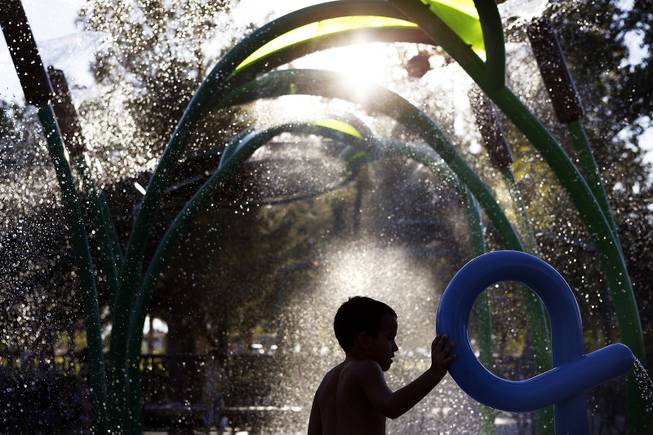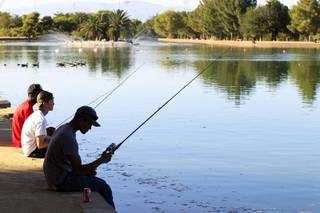
Sunset Park offers a water park feature in one of several playgrounds in Las Vegas on Tuesday, August 13, 2013.
Thursday, Aug. 15, 2013 | 2 a.m.
Related content
As new housing developments sprouted up seemingly every week across the valley during the height of economic boom, local parks officials worked at a breakneck pace to keep the region’s green spaces growing along with the population.
Backed by a seemingly endless supply of money from public land sales, local governments went on a park-building frenzy, designing and constructing everything from five- to 10-acre neighborhood sites, all the way up to the $42 million, 120-acre Centennial Hills park in northwest Las Vegas.
“It was like an assembly line,” said Mike Henley, deputy director of community services and development for North Las Vegas.
The effects of that spending still are being felt today, with the recent completion of $11.7 million worth of renovations at Sunset Park, one of the valley’s oldest and largest parks, and the recent opening of Cornerstone Park in Henderson. On Saturday, Las Vegas will unveil $30 million worth of renovations to the historic Lorenzi Park while North Las Vegas is preparing for the October opening of the $126 million Craig Ranch Park.
All these projects and many more were paid for using money generated through the Southern Nevada Public Land Management Act, which diverts 85 percent of the revenue from federal land sales around the valley into a dedicated fund to pay for parks, trails, environmental conservation and wildfire prevention, among other things.
But the faucet has run dry as public land sales have dropped precipitously from a high of 2,924 acres in 2006, which generated $777 million, to an average of 17.8 acres per year between 2007 and 2012, decimating the main source of funding local governments have used to develop their park systems.
On Wednesday, the executive committee overseeing the SNPLMA program, which is run by the Bureau of Land Management, will meet to discuss how to divvy up $8.7 million in grant funding, only about $1.4 million of which will go toward local parks and trails. The money will fund about two dozen programs at several hundred thousand dollars each, a far cry from the $884 million the agency gave out at its peak in 2006.
The steep decline and tepid outlook for recovery has led to a relative freeze in new parks and trail development. While projects like Cornerstone Park and Craig Ranch were carried to completion by funding that was approved during the flush years, the drop in funding is beginning to catch up with parks departments, which are scaling back projects and struggling to find new ways to pay for continued development.
One example of this cash crunch is at Mountain's Edge Regional Park. The county broke ground in April on the first phase of SNPLMA-funded construction, which will add playgrounds, picnic areas, a walking trail and parking on 15 acres at a cost of $8 million. Eventually, the county envisions a recreational center, skate park, sports fields and amphitheater at the 220-acre site. But without a dedicated source of funding, there’s no timeline for when future phases of the park will be built, said Jon Wardlaw, a planning manager with Clark County Comprehensive Planning.
“It’s probably more needed than ever in that area. That’s where our growth is,” he said. “Every day and every development that goes by, every extra house adds need for the facility. It’s really difficult unless you’ve got a dedicated funding source to know how fast and how quickly we can prioritize projects. If a park’s 200 acres, do you take it in 10-acre parts, 25-acre parts or 50-acre parts?”
While other cities use tax levies, voter-approved bonds or portions of their capital budgets, Southern Nevada officials and residents have become accustomed to relying on public land revenues to pay for new parks, an arrangement unique to Nevada. Without the public land money, parks departments are getting creative by pursuing grant funding or partnerships with home developers to get projects built.
Building out the regional trail network, which is cheaper and easier to do than parks, is another way governments are attempting to keep moving the region forward on a shoestring budget.
“Unlike a park where you’ve got to have athletic fields to get a critical mass of interest, people use trails all the time,” Henley said. “The trend nationally has been to go more toward trail development because you tend not to have as high of acquisition costs, because you can use utility easements.”
With the breakneck growth and subsequent demand for parks tapering off, local parks officials also are turning much of their attention to existing parks and investing what little funding they have in upgrading those facilities.
“We’re readjusting our focus. Maybe there isn’t $16 million available, but there might be $300,000 that we could apply for renovations to something like Fox Ridge park, which is very well loved and used,” said Henderson Parks and Recreation spokeswoman Kim Becker. “We’re reinvesting in our assets.”
Taking care of existing parks has become an increasing challenge as local governments have cut back on staff and budgeting, limiting the amount of maintenance they’re able to do.
In Clark County, that has meant broken sprinklers take an extra day or two to get fixed, or that some parks aren’t mowed and picked up as often as in earlier days.
But in North Las Vegas, the cost of maintaining Craig Ranch, expected to be about $1.7 million per year, is putting a serious strain on the already cash-strapped city, which has run budget deficits of $30 million in recent years.
Annual maintenance on a park can range from $6,000 to $10,000 per acre per year, depending on the amenities. While large parks like Craig Ranch are expensive to operate because of their sheer size, on a per-acre basis it’s often the remote neighborhood parks that drive up maintenance costs, Henley said.
“As a manager of a parks system, I would prefer to have larger but fewer parks. That’s much easier to program and maintain,” he said. “But when you talk to residents, they like the convenience of having smaller facilities that are more accessible.”
Although 39,000 acres of public land in the valley still are owned by the BLM and could potentially be auctioned one day to infuse new cash into the regional parks system, there’s no telling whether sales will ever return to the level that fueled the rapid expansion of the past decade.
Even with recent construction, the area still lags behind national averages for the amount of park space per resident. Still, local departments are aiming to have a park, be it big or small, within walking distance of every home in the urban valley, even if such an idea might take longer than they initially thought.
“Our true goal is to have a park or trail within a half-mile of every home,” Becker said. “If people have access to it, they’ll use it. You don’t need money, you don’t need anything. You can just go toss a ball or have a picnic.”


Join the Discussion:
Check this out for a full explanation of our conversion to the LiveFyre commenting system and instructions on how to sign up for an account.
Full comments policy